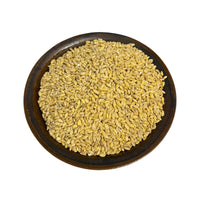

Our Organic Pearled Barley is grown and milled by Four Leaf Milling, a family-run operation in Tarlee, South Australia. With a focus on regenerative organic farming and traditional wholegrain milling methods, Four Leaf has been a trusted name in Australian organics since 1983.
This barley has been lightly polished to remove the indigestible outer hull, resulting in a quicker cooking time and a softer texture – perfect for hearty meals and everyday cooking.
About the Mill
Founded by Gavin Dunn in the Gilbert Valley of South Australia, Four Leaf Milling has spent over four decades dedicated to organic grain processing with minimal intervention. Their commitment to sustainable agriculture, nutritional integrity, and small-batch craftsmanship makes them a cornerstone of Australia’s wholefood movement. You can learn more about Four Leaf on their bio page →
What is Pearled Barley?
Pearled barley is whole barley grain that has been hulled and gently polished to remove part of the outer husk. While not a wholegrain, it retains many of barley’s nutrients and has the advantage of cooking much faster and absorbing flavour beautifully.
Unlike hulled barley, which is chewy, hard to digest and takes longer to cook, pearled barley is softer and ideal for a wide range of dishes – from slow-cooked soups to grain bowls and even risottos.
Culinary Uses
Pearled barley is one of the most versatile pantry staples. Use it to:
-
Add bulk and texture to soups and stews
-
Replace rice in pilafs and risottos
-
Create nourishing grain salads and warm bowls
-
Brew traditional drinks like barley tea or barley water
To cook:
Rinse thoroughly, then simmer in a ratio of 1:3 (barley:water) for 40–50 minutes, or until tender.
Why We Love It
-
Grown and milled in Australia by a certified organic family mill
-
Minimal processing preserves natural flavour and fibre
-
Soft, nutty texture that works across savoury and sweet dishes
-
A shelf-stable, affordable wholefood for everyday meals
FAQs
Is pearled barley a wholegrain?
Technically, no. The pearling process removes the outer bran layer, which means it’s not considered a true wholegrain. However, it still retains valuable nutrition, including fibre and complex carbohydrates.
Is pearled barley gluten free?
No. Barley contains a form of gluten and is not suitable for people with coeliac disease or gluten intolerance. To read more about the complexity that surrounds gluten, have a read of our blog post on gluten
How should I store pearled barley?
Keep it in an airtight container in a cool, dry place out of direct sunlight. For long-term storage, refrigeration or freezing can help extend freshness. For more information on storage, here is a little piece we wrote.
What’s the difference between hulled and pearled barley?
Hulled barley retains its takes a lot longer to cook and has a bit more fibre. Pearled barley has the hull polished off, making it easier to digest (less fibrous) quicker to cook and softer in texture – better for nearly all culinary uses.
Product repacked by Sovereign Foods in compostable bags.
Our Bags are made from brown recycled paper and have a 100% natural corn-based compostable biofilm. All you need to do is pop off the label before you put it in your compost (We are looking for a cost-effective compostable solution to our labels). These bags are a good short term but are not completely airtight. When you get your goodies home, be sure to pop your products into a jar and store them in a cool, dry place out of sunlight. You can reuse these bags around the house as a short-term solution to keep things dry and reduce air contact.
Weight:
Dimensions: x x
Product contains Gluten and packed in a facility that stores and packs products that contain Nuts and Soy
Growing Methods:



